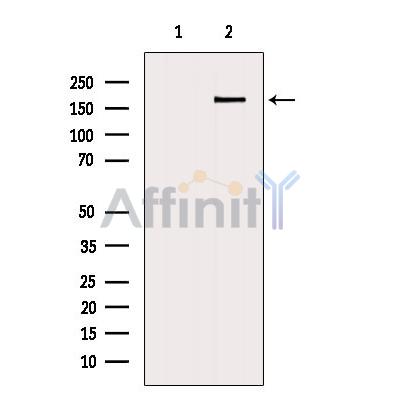ZFYVE16 Antibody - #DF12507
| Product: | ZFYVE16 Antibody |
| Catalog: | DF12507 |
| Description: | Rabbit polyclonal antibody to ZFYVE16 |
| Application: | WB IHC IF/ICC |
| Reactivity: | Human, Mouse, Rat |
| Prediction: | Bovine, Horse, Sheep, Dog, Chicken |
| Mol.Wt.: | 169 kDa,250 kDa; 169kD(Calculated). |
| Uniprot: | Q7Z3T8 |
| RRID: | AB_2845312 |
Related Downloads
Protocols
Product Info
*The optimal dilutions should be determined by the end user. For optimal experimental results, antibody reuse is not recommended.
*Tips:
WB: For western blot detection of denatured protein samples. IHC: For immunohistochemical detection of paraffin sections (IHC-p) or frozen sections (IHC-f) of tissue samples. IF/ICC: For immunofluorescence detection of cell samples. ELISA(peptide): For ELISA detection of antigenic peptide.
Cite Format: Affinity Biosciences Cat# DF12507, RRID:AB_2845312.
Fold/Unfold
AI035632; B130024H06Rik; B130031L15; DKFZp686E13162; Endofin; Endosomal associated FYVE domain protein; Endosome associated FYVE domain protein; Endosome-associated FYVE domain protein; KIAA0305; KIAA0305;; mKIAA0305; OTTMUSP00000029589; RGD1564784; ZFY16_HUMAN; ZFYVE16; Zinc finger FYVE domain containing protein 16; Zinc finger FYVE domain-containing protein 16; Zinc finger, FYVE domain containing 16;
Immunogens
A synthesized peptide derived from human ZFYVE16, corresponding to a region within C-terminal amino acids.
Widely expressed. Highly expressed in kidney, placenta and lung. Expressed at intermediate level in heart, brain, skeletal muscle, spleen and liver. Weakly expressed in colon, thymus and peripheral blood lymphocytes.
- Q7Z3T8 ZFY16_HUMAN:
- Protein BLAST With
- NCBI/
- ExPASy/
- Uniprot
MDSYFKAAVSDLDKLLDDFEQNPDEQDYLQDVQNAYDSNHCSVSSELASSQRTSLLPKDQECVNSCASSETSYGTNESSLNEKTLKGLTSIQNEKNVTGLDLLSSVDGGTSDEIQPLYMGRCSKPICDLISDMGNLVHATNSEEDIKKLLPDDFKSNADSLIGLDLSSVSDTPCVSSTDHDSDTVREQQNDISSELQNREIGGIKELGIKVDTTLSDSYNYSGTENLKDKKIFNQLESIVDFNMSSALTRQSSKMFHAKDKLQHKSQPCGLLKDVGLVKEEVDVAVITAAECLKEEGKTSALTCSLPKNEDLCLNDSNSRDENFKLPDFSFQEDKTVIKQSAQEDSKSLDLKDNDVIQDSSSALHVSSKDVPSSLSCLPASGSMCGSLIESKARGDFLPQHEHKDNIQDAVTIHEEIQNSVVLGGEPFKENDLLKQEKCKSILLQSLIEGMEDRKIDPDQTVIRAESLDGGDTSSTVVESQEGLSGTHVPESSDCCEGFINTFSSNDMDGQDLDYFNIDEGAKSGPLISDAELDAFLTEQYLQTTNIKSFEENVNDSKSQMNQIDMKGLDDGNINNIYFNAEAGAIGESHGINIICEIVDKQNTIENGLSLGEKSTIPVQQGLPTSKSEITNQLSVSDINSQSVGGARPKQLFSLPSRTRSSKDLNKPDVPDTIESEPSTADTVVPITCAIDSTADPQVSFNSNYIDIESNSEGGSSFVTANEDSVPENTCKEGLVLGQKQPTWVPDSEAPNCMNCQVKFTFTKRRHHCRACGKVFCGVCCNRKCKLQYLEKEARVCVVCYETISKAQAFERMMSPTGSNLKSNHSDECTTVQPPQENQTSSIPSPATLPVSALKQPGVEGLCSKEQKRVWFADGILPNGEVADTTKLSSGSKRCSEDFSPLSPDVPMTVNTVDHSHSTTVEKPNNETGDITRNEIIQSPISQVPSVEKLSMNTGNEGLPTSGSFTLDDDVFAETEEPSSPTGVLVNSNLPIASISDYRLLCDINKYVCNKISLLPNDEDSLPPLLVASGEKGSVPVVEEHPSHEQIILLLEGESFHPVTFVLNANLLVNVKFIFYSSDKYWYFSTNGLHGLGQAEIIILLLCLPNEDTIPKDIFRLFITIYKDALKGKYIENLDNITFTESFLSSKDHGGFLFITPTFQKLDDLSLPSNPFLCGILIQKLEIPWAKVFPMRLMLRLGAEYKAYPAPLTSIRGRKPLFGEIGHTIMNLLVDLRNYQYTLHNIDQLLIHMEMGKSCIKIPRKKYSDVMKVLNSSNEHVISIGASFSTEADSHLVCIQNDGIYETQANSATGHPRKVTGASFVVFNGALKTSSGFLAKSSIVEDGLMVQITPETMNGLRLALREQKDFKITCGKVDAVDLREYVDICWVDAEEKGNKGVISSVDGISLQGFPSEKIKLEADFETDEKIVKCTEVFYFLKDQDLSILSTSYQFAKEIAMACSAALCPHLKTLKSNGMNKIGLRVSIDTDMVEFQAGSEGQLLPQHYLNDLDSALIPVIHGGTSNSSLPLEIELVFFIIEHLF
Predictions
Score>80(red) has high confidence and is suggested to be used for WB detection. *The prediction model is mainly based on the alignment of immunogen sequences, the results are for reference only, not as the basis of quality assurance.
High(score>80) Medium(80>score>50) Low(score<50) No confidence
Research Backgrounds
May be involved in regulating membrane trafficking in the endosomal pathway. Overexpression induces endosome aggregation. Required to target TOM1 to endosomes.
Cytoplasm. Early endosome membrane>Peripheral membrane protein.
Note: Localized to early endosomes. Membrane-associated, probably via its association with phosphatidylinositol 3-phosphate (PI3P).
Widely expressed. Highly expressed in kidney, placenta and lung. Expressed at intermediate level in heart, brain, skeletal muscle, spleen and liver. Weakly expressed in colon, thymus and peripheral blood lymphocytes.
The FYVE-type zinc finger is necessary and sufficient for its localization into early endosomes and mediates the association with PI3P.
Research Fields
· Cellular Processes > Transport and catabolism > Endocytosis. (View pathway)
· Environmental Information Processing > Signal transduction > TGF-beta signaling pathway. (View pathway)
Restrictive clause
Affinity Biosciences tests all products strictly. Citations are provided as a resource for additional applications that have not been validated by Affinity Biosciences. Please choose the appropriate format for each application and consult Materials and Methods sections for additional details about the use of any product in these publications.
For Research Use Only.
Not for use in diagnostic or therapeutic procedures. Not for resale. Not for distribution without written consent. Affinity Biosciences will not be held responsible for patent infringement or other violations that may occur with the use of our products. Affinity Biosciences, Affinity Biosciences Logo and all other trademarks are the property of Affinity Biosciences LTD.

